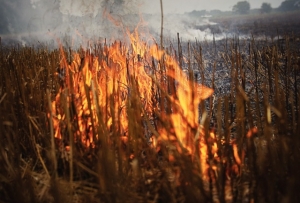Wheat harvest is under way
By Steve Herring
Published in News on June 11, 2012 1:46 PM

News-Argus/MICHAEL BETTS
William Earl Cruse watches as a leftover field of wheat stalks goes up in flames on the Billy Lee farm near Goldsboro. Area farmers have been using the recent stretch of dry weather to catch up on harvesting their wheat crop. Many burn away the residue to make room for a second crop, usually soybeans. Wayne County farmers planted more than 30,000 acres of wheat this year and most expect a good yield.

News-Argus/MICHAEL BETTS
The remnants of this season's wheat crop burn as land is prepared for next use.
The billowing black plumes of smoke across the Wayne County landscape as fields are burned off tell the tale -- the wheat harvest is under way in Wayne County.
"I think we have come through all of this rain well if we can get it out. I think we are in probably good shape. They just need to get it out of the field," said field crop agent John Sanderson of the Wayne County Cooperative Extension Service.
Rain had been preventing farmers from getting in the fields, but a spate of dry weather last week gave farmers the chance to pick the wheat, which can't be harvested when it is wet.
Early indications are that area farmers will have a good crop, even if it's not on par with last year's harvest, which produced an unusually high yield.
Wayne County has 34,575 acres planted in wheat this year -- the most ever -- said Rick Tharrington, the executive director for the Wayne County Farm Service Agency. The second highest planting was in 2007-08 at 32,044 acres.
But having the most acres in wheat doesn't necessarily guarantee the biggest yield, Tharrington said. The dry spell in late winter and a late frost in April likely reduced the overall yield. And recent rains have kept farmers from harvesting on time, also cutting down on the yield, he said.
How different fields fared depends on where they are located, Sanderson said. Some areas might have suffered 50 percent in damages while losses in other areas, sometimes within the same field, might be minimal, he said.
Northern Wayne County appears to have escaped frost damage that hit the southern part of the county, Sanderson said.
Excessive rain and moisture can reduce yields through crop lodging, wheat sprouting in the head, and wheat falling out of the heads on the ground, Sanderson said. Also, wind associated with storms can increase the problems.
"After wheat is mature every time it rains the quality of the crop declines by reducing the test weight," he said. "A bushel of wheat is 60 pounds. However, as the volume remains the same the weight declines. If the test weight drops below certain levels the grain is docked, which results in reduced price from the loss of quality.
"The bottom line is as harvest is delayed from excessive rain, yield and quality of the wheat crop declines which reduces the value of the crop to the farmer. Also, delaying wheat harvest delays planting soybeans behind the wheat crop which also can reduce the yield potential of the soybean crop as well."
As the wheat season continues, people can expect to see the smoke as farmers burn off the debris left by the harvest, but possibly not as much as has been seen in recent years. While it is the traditional way of clearing the field, the practice is not as common as it once was, Sanderson said. More and more farmers are choosing to no-till the next crop right over the cut wheat stalks. Sanderson estimated that 20 percent or less of the fields are still cleared by fire.
